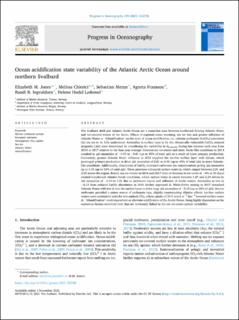| dc.contributor.author | Jones, Elizabeth Marie | |
| dc.contributor.author | Chierici, Melissa | |
| dc.contributor.author | Menze, Sebastian | |
| dc.contributor.author | Fransson, Agneta | |
| dc.contributor.author | Ingvaldsen, Randi Brunvær | |
| dc.contributor.author | Lødemel, Helene Hodal | |
| dc.date.accessioned | 2021-11-26T11:41:55Z | |
| dc.date.available | 2021-11-26T11:41:55Z | |
| dc.date.created | 2021-11-22T22:52:25Z | |
| dc.date.issued | 2021 | |
| dc.identifier.citation | Progress in Oceanography. 2021, 199 . | |
| dc.identifier.issn | 0079-6611 | |
| dc.identifier.uri | https://hdl.handle.net/11250/2831657 | |
| dc.description.abstract | The Svalbard shelf and Atlantic Arctic Ocean are a transition zone between northward flowing Atlantic Water and ice-covered waters of the Arctic. Effects of regional ocean warming, sea ice loss and greater influence of Atlantic Water or “Atlantification” on the state of ocean acidification, i.e. calcium carbonate (CaCO3) saturation (Ω) are yet to be fully understood. Anomalies in surface layer Ω for the climatically-vulnerable CaCO3 mineral aragonite (ΔΩ) were determined by considering the variability in Ωaragonite during late summer each year from 2014 to 2017 relative to the four-year average. Greatest sea ice extent and more Arctic-like conditions in 2014 resulted in ΔΩ anomalies of −0.05 to −0.01 (up to 45% of total ΔΩ) as a result of lower primary production. Conversely, greater Atlantic Water influence in 2015 supplied the ice-free surface layer with nitrate, which prolonged primary production to drive ΔΩ anomalies of 0.01 to 0.06 (up to 45% of total ΔΩ) in more Atlantic-like conditions. Additionally, dissolution of CaCO3 increased carbonate ion concentrations giving ΔΩ anomalies up to 0.06 (up to 52% of total ΔΩ). These processes enhanced surface water Ω, which ranged between 2.01 and 2.65 across the region. Recent sea ice retreat in 2016 and 2017 (rate of decrease in ice cover of ∼4% in 30 days) created transitional Atlantic-Arctic conditions, where surface water Ω varied between 1.87 and 2.29 driven by ΔΩ anomalies of −0.10 to 0.01 due to meltwater inputs and influence of Arctic waters. Anomalies as low as −0.12 from reduced CaCO3 dissolution in 2016 further supressed Ω. Wind-driven mixing in 2017 entrained Atlantic Water with low Ω into the surface layer to drive large ΔΩ anomalies of −0.15 (up to 58% of ΔΩ). Sea-ice meltwater provided a minor source of carbonate ions, slightly counteracting dilution effects. Ice-free surface waters were substantial sinks for atmospheric CO2, where uptake of 20.5 mmol m−2 day−1 lowered surface water Ω. “Atlantification” could exacerbate or alleviate acidification of the Arctic Ocean, being highly dependent on the numerous factors examined here that are intricately linked to the sea ice-ocean system variability. | |
| dc.language.iso | eng | |
| dc.title | Ocean acidification state variability of the Atlantic Arctic Ocean around northern Svalbard | |
| dc.type | Peer reviewed | |
| dc.type | Journal article | |
| dc.description.version | publishedVersion | |
| dc.source.pagenumber | 24 | |
| dc.source.volume | 199 | |
| dc.source.journal | Progress in Oceanography | |
| dc.identifier.doi | 10.1016/j.pocean.2021.102708 | |
| dc.identifier.cristin | 1957533 | |
| dc.relation.project | Norges forskningsråd: 226415 | |
| dc.relation.project | Norges forskningsråd: 228896 | |
| cristin.ispublished | true | |
| cristin.fulltext | original | |
| cristin.qualitycode | 1 | |
